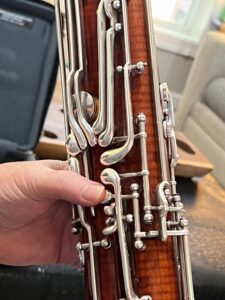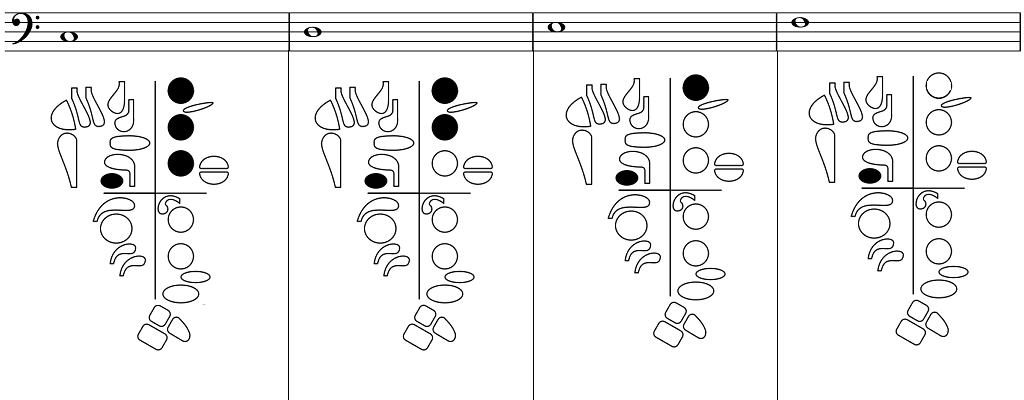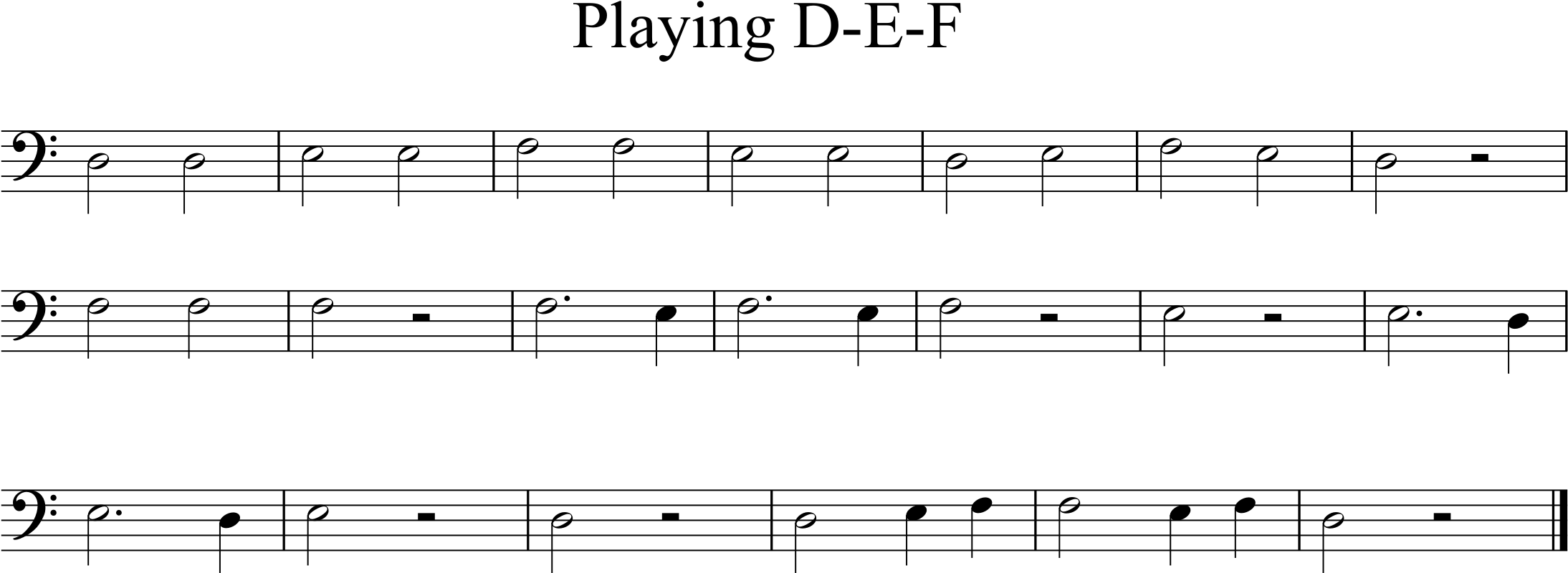Hand Position Reminder:
The left hand goes on top, and the fingers wrap around the long and wing joints. The base of the left index finger supports the bassoon as it rests against the long joint.


Keep fingers and thumb relaxed with a natural curve.
Use pads of fingers to cover all holes completely.
Use the end of your thumb to press the whisper key down.
Note: Avoid squeezing with your fingers. If the end joint on your index and/or middle finger is collapsing, you are pressing too hard. Collapsed end joints will slow your technique and make your hands tired.
Fingerings:

Tips for the first notes:
- Notes are part of a C major scale segment.
- Only one finger changes between each of these notes.
- Keep your hands and fingers soft with a light touch on the tone-holes.
Air & Ear Reminders:
- Use your AIR! Blow a constant and strong stream of air into the bassoon.
- Use your EAR! Give yourself an aural target by playing a drone to match. One of my favorite online sites is www.tuningdrones.com. Having an aural target is the best way to develop accurate intonation and boost your tuning confidence!
- Articulate each note by lightly tapping the front of your tongue against the reed at the start of each note.
The first exercise (Matching Pitch) will help you work on intonation. You should play this exercise on each new note you learn. It will help you address response and intonation. Your AIR and your EAR are your most powerful musical tools. Pay attention to both and you will make excellent progress.

Repeat Matching Pitch but play the third line D instead of C. Listen to the reference tone and support your sound with your air.

Counting: The numbers above each bar represent the quarter note beats and are a reminder to count the beats while you are playing. The meter is 4/4 which means there are four beats in each measure and the quarter note gets the beat. Count at a steady pace (tempo) and be sure to count the beats in your head while you are playing so you always know where you are in the bar.

Play Matching Pitch on third space E; your next new note.

Note: The third-space E can be tricky to play in tune. It can tend to sag flat by as much as a half step. Here are some suggestions to fix a flat third-space E natural:
- Hear the pitch accurately before you play the E.
- Take a full breath and blow a steady air stream.
- Try increasing your hug on the reed just a little. Squeezing too hard will make the problem worse.
- If these suggestions do not work, the reed might be the problem. See chapter 89 “Simple Reed Adjustments” for tips to adjust your reed.
Once you feel comfortable with the E, move on to Playing D & E. Be sure to count in your head as you play the notes.

Now you are ready to play some tunes using these three notes.
Remember to:
- Use your AIR (blow steady air)
- Use your EARS to aim the pitch of each note (hear the tune in your head as you play).
- Articulate each note.
- Count four beats per bar.


Improvise
How many tunes can you come up with that use only the notes you’ve learned so far?
Create your own tunes by improvising around these three notes and any rhythms and articulations you feel like playing.
Balancing the bassoon on “open” middle F
The whisper key, pressed by the left thumb, is the only key needed to play middle (open) F. None of the holes on the front of the bassoon should be covered for middle F.
Note: This makes the third point of support and balance especially important. Having a solid point of contact at the base of your left index finger will allow you to support and balance the wing and long joints when you lift your fingers away from the holes and not feel like you’re going to drop the bassoon.

Focus on this balance point as you play through the tuning exercise on middle F.


Simple Song
The meter for Simple Song is 6/8. Start by counting in 6 with one number/beat on each eighth note. Once you get comfortable with the notes and fingerings, try putting a heavy accent on beats 1 and 4 and play beats 2, 3, 5, and 6 without accent. This will create the feel of having 2 big beats in each bar, with each big beat having 3 small beats. Feeling the 2 big beats per bar will help create the special lilting (dancing) feel for which 6/8 meter is known.
Tie: The curved line used in bars 2, 4, and 8 is a tie. A tie is used to connect two notes that are the same pitch. Hold the C for the full time notated (5 eighth notes) but do not articulate the second C in the bar.
Tip: Keeping your fingers close to the bassoon when you pick them up to move to the next note will make putting them back down with precision much easier and will help you sound even better.

Improvise
Take a few minutes to improvise using the left-hand notes you’ve learned in this lesson. If another bassoonist is available, partner up and play your tunes for each other. See if you can copy what your partner plays and vice versa.

Feedback/Errata